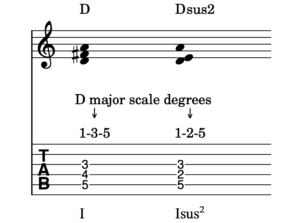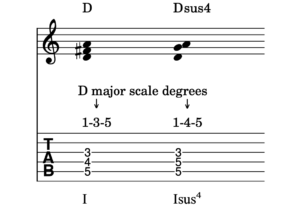Suspended Chords
Suspended chords are a great way to get fresh, interesting chord sounds without excess effort. Let’s discuss what a suspended chord is, the different types of suspended chords, and how we can apply them to our playing.
What’s a sus chord?
Like an object launched into the air, a suspended chord evokes the sensation of both lift and the need to resolve to a more stable place. The suspension creates tension and the anticipation of movement, along with an urge for the chord progression to continue until it reaches a satisfactory resolution.
Only one note need be changed in order to convert a major or minor chord into a suspended chord.
Beginning with a basic major triad (root, 3rd, 5th), we form a suspension by raising or lowering the 3rd of the triad. There are two basic types of suspended chords: sus2 and sus4. All examples will be in the key of D major.

The tab here is for guitar in open D tuning and similar tunings. The staff notation is, of course, universal.
Note: A triad is an arrangement of three notes that together form a chord. If you’re unsure of how to form a triad, check out our article on triads. Triads are fundamental to the formation of complex chords, and knowing how to form triads makes all other music theory concepts easier to learn.
A sus2 chord is formed by moving the 3rd of the major triad down to the closest scale degree below it. In other words, we replace the 3rd of the major triad with the note a major 2nd interval (two half steps) above the root. If we’re in the key of D, the D major triad is formed with the scale degrees 1-3-5. By moving the 3 down to the 2, and we now have 1-2-5: this is a sus2 chord. (For more background on the major scale, see The All-Important Major Scale.)

To form a sus4 chord, move the 3rd of the major triad up a half step (one fret). We replace the 3rd of the chord with the note a perfect 4th interval (four half steps) above the root. Playing a D major triad in the key of D, this means moving the 3rd scale degree up to the 4th scale degree. The result is 1-4-5: a Dsus4 chord.

To recap: A sus2 chord is formed by lowering the 3rd, and a sus4 is formed by raising the 3rd. The other two notes of the triad (the root and the 5th) don’t move. We can clearly hear how this simple movement creates tension that wants to be resolved. Normally, suspended chords resolve to a more stable chord form. For instance, a Dsus4 usually (though not always) resolves down to a D major chord. A Dsus2 likes to resolve up to a D major.

How many suspended chords are there in a given key?
There are quite a few suspended chords in a given key, and they all sound great. For now we’ll focus on sus4 chords—they’re more common, and as we’ll discover in a subsequent lesson in this series of articles on suspended chords, sus4 and sus2 chords are two sides of the same coin.
There are seven diatonic triads in the key of D major: D, Em, F#m, G, A, Bm, C#˚. (Diatonic triads are formed by using only the scale degrees of the key.) Five of those seven triads can become sus4 chords simply by changing one note of each triad. One becomes a sus#4 (more on that in part 2 of this series on sus chords). The resulting sus4 triads resolve nicely to the major or minor triad from which they’re derived.

How cool does that sound? There are many ways you can use suspended chords in your playing, and we’ll talk about them all in future articles. One thing that’s for sure is that suspended chords are very effective as passing chords—as bridges used to pass from one chord in the progression to another.
To start applying suspended chords to your playing, take a simple chord progression, and add the respective suspended chord before each chord. The diagram above should help to get you started.
If you’re interested in learning more music theory in Open D, check out the book Mastering the Fretboard in Open D and the 3+ hour video course Mastering Open D Tuning.
And stay tuned, more articles about suspended chords and many other topics are coming soon.
RELATED LESSONS YOU’LL ENJOY:
Join our mailing list to receive the latest tips!